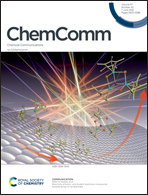Eshelby untwisting†
Abstract
The concept of Eshelby untwisting, the effect of an axial screw dislocation driving an intrinsically twisted nanocrystal towards a straighter configuration more consistent with long–range translational symmetry, is introduced here. Force-field simulations of nanorods built from the enantiomorphous (space groups, P3121 and P3221) crystal structures of benzil (C6H5–C(O)–C(O)–C6H5) were previously shown to twist in opposite directions, even in the absence of dislocations. Here, both right- and left-handed screw dislocations were introduced into benzil nanorods in silico. For rods built from the P3221 enantiomorph, dislocations with negative Burgers vectors increased the right-handed twisting already present in the intrinsically twisted structures without dislocations, whereas dislocations with positive Burgers vectors drove the twisted structure back towards a straight configuration, untwisting. In the dynamic simulations, the P3221 helicoid endowed with a positive Burgers vector ultimately twisted back through the straight configuration, until a helicoid of opposite sense from that of the starting structure, was obtained. The bearing of these observations on the propensity of small crystals to adopt non-polyhedral morphologies is discussed.



 Please wait while we load your content...
Please wait while we load your content...